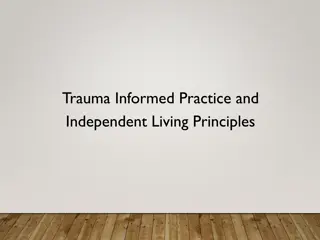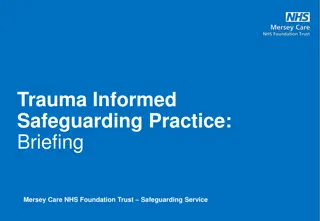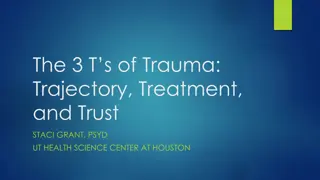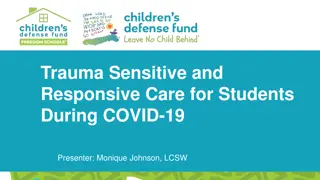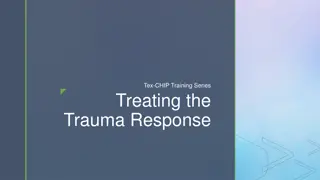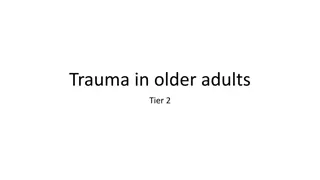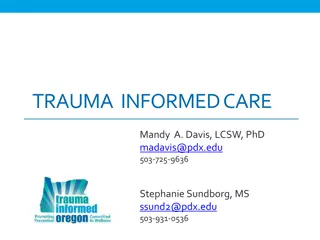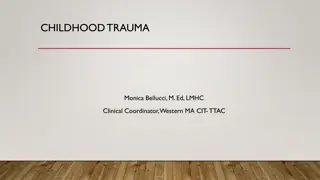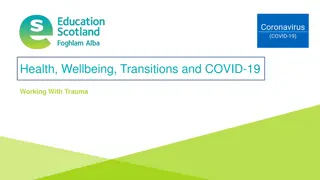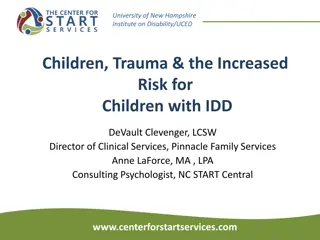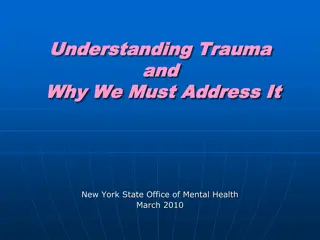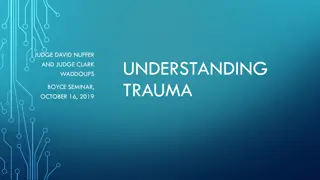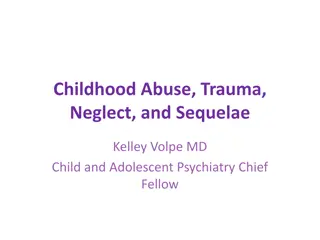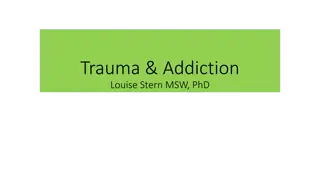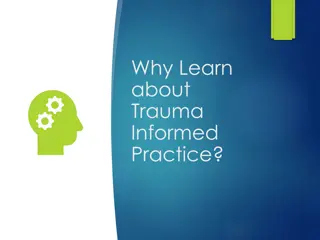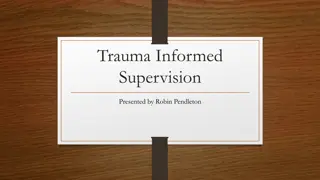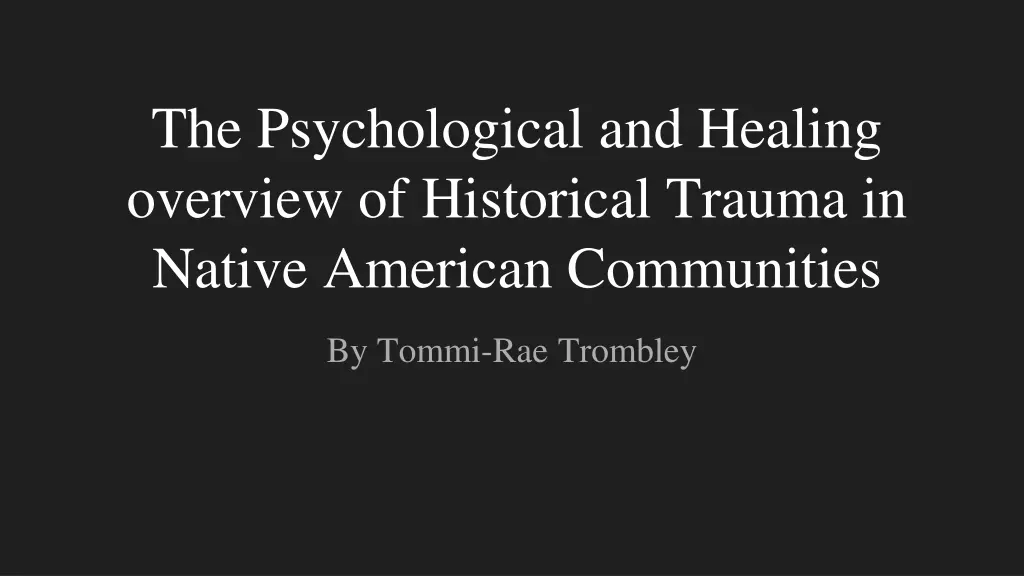
Understanding Historical Trauma in Native American Communities
Explore the psychological and healing overview of historical trauma in Native American communities, analyzing the impact of generational trauma, symptoms of historical loss, and the prevalence of mental health concerns. Gain insights into the intergenerational experiences of oppression and the importance of breaking free from generational trauma for resilience and healing.
Download Presentation

Please find below an Image/Link to download the presentation.
The content on the website is provided AS IS for your information and personal use only. It may not be sold, licensed, or shared on other websites without obtaining consent from the author. If you encounter any issues during the download, it is possible that the publisher has removed the file from their server.
You are allowed to download the files provided on this website for personal or commercial use, subject to the condition that they are used lawfully. All files are the property of their respective owners.
The content on the website is provided AS IS for your information and personal use only. It may not be sold, licensed, or shared on other websites without obtaining consent from the author.
E N D
Presentation Transcript
The Psychological and Healing overview of Historical Trauma in Native American Communities By Tommi-Rae Trombley
Introduction to Understanding Historical Trauma Trauma is the response to an unsettling event such as danger. Historical trauma is a original experience passed down generation from generation whether that be learned behaviorally, learned socially, or imbedded in our DNA. Native Americans for the past centuries have underwent heavy colonization and was violently assimilated into the european society dehumanizing Native Americans. Being stripped of the land, identity, cultural practices, ect. Leaving us with destruction in Native American lives then and now. The importance of learning trauma is to understand where the pain stems from and how to break free from generational trauma.The points of interest are how generational trauma impacts Native Americans psychologically and what sort of healing process will help bring hope and resilience into Native American Communities.
Understanding Trauma Trauma is the body's response to danger or a distressing event. Which leads to long lasting effects on the body and mind. Trauma gives feelings of depression, sadness, anxiety, confusion, numbness, hopelessness,ect. Other symptoms include insomnia, trouble with relationships, emotional outbursts, and nightmares. The physical symptoms are nausea, dizziness, headaches, changes in sleeping patterns as well as appetite changes. Some Psychological disorders from trauma may include, PTSD, depression, anxiety, substance abuse problems, and dissociative problems. Trauma also affects our homeostasis, functioning on the sympathetic nervous system, and endocrine system.
What is Historical Trauma and Core Concepts Historical trauma is a intergenerational experience by a community that has in the past been or continues to be oppressed. Showing psychologically, biologically, and socially. Symptoms and responses of historical loss may include, depression, anger, sometimes PTSD, fixation on trauma, low self-esteem, victim identity, numbing, internalization to ancestral suffering, intense fear, substance abuse, self destructive behaviors, dissociation. Examples of historical trauma. The violently forces colonialism on Native Americans, genocide, boarding school era.
Psychological Concerns & general concerns Native Americans have a lower life expectancy of 5.5 years less than the us population. High rates of substance abuse disorders along with mental health disorders Overrepresentation in cardiovascular disease, diabetes, STD s, liver disease. In 2014 suicide was the second leading cause of death between the ages 10 and 34 in native american communities.
The effect of Trauma on the Physiological Functioning When the body experiences trauma or perceived danger in needs glucose and oxygen in order to flee or fight from the perceived danger. Adrenal glands is sent a message by the brain to release epinephrine to increase the amount of sugar in the bloodstream to increase energy. This then increases the heart rate and raises blood pressure The brain also sends a message to the pituitary gland, to the adrenal cortex to release more cortisol. Experience from trauma can cause and over hyperactive amygdala . This hyperactivity is a key element in PTSD disorders giving exaggerated startle response of angry outbursts, irritability, When time has passed after the original traumatic experience triggers that remind us of the traumatic experience linger, such as smell, sound, gestures, face, are some of the strongest triggers that can trigger the fight or flight response.
Historical Trauma Sources 1879 Boarding School Policy - Physical, emotional, and sexual abuse. Loss of identity, language, traditional practices. No family systems. Termination of culture and forced assimilation. Religious Crime Code of 1883 - banning all Native Americans from all forms of ceremonies, medicine, prayer, dancing, ect. Loss of identity, language, traditions. Loss of ability to mourn and healthy cope with trauma. Termination of culture and forced assimilation. Starvation Winter 1883-84, Massacre on the Marias River 1870, Smallpox Epidemic 1837. - Loss of people. Traumatic experiences. Starvation Winter was a loss of independence. Forced upon Laws and Policies - Loss of independence, loss of sovereignty for tribes.
How Trauma Continues to Repeat Over Generations Unresolved trauma Oppression internalizing Picking up patterns from adults such as grief, communication styles, parenting techniques, bad habits. Epigenetics
Breaking Generational Curses Confronting unresolved trauma within yourself Understanding the trauma Releasing the pent up trauma Rise above the trauma
Resilience: Finding Hope and Comfort in our Traditional ways Breaking generational patterns is coming to terms with unresolved grief and unrecognized greif Traditional ceremonies, medicines, prayer, diets. Having healthy outlets such as journaling, going to a counselor, physical exercise, taking care of oneself physically and emotionally. Re-introducing traditional ways to younger generations.
Sakowin (Seven Laws of the Lakota) Generosity - Wacante Compassion - Wowaunsila Respect - Wowayuonihan To Have a Great Mind - Wowacin Tanka Humility, State of Silence, to be Humble - Wowahwala Courage, Bravery, Principal, Discipline - Woohitike Wisdom, understanding - Woksape
Citations The return to the sacred path: Reflections on the development of historical trauma healing. United for Youth. (n.d.). Retrieved August 16, 2022, from https://www.unitedforyouth.org/best-promising-innovative-work-underway/the-return- to-the-sacred-path-reflections-on-te Office of Minority Health. Mental and Behavioral Health - American Indians/Alaska Natives - The Office of Minority Health. (n.d.). Retrieved August 16, 2022, from https://www.minorityhealth.hhs.gov/omh/browse.aspx?lvl=4&lvlid=39 Substance Abuse Statistics for Native Americans. American Addiction Centers. (2022, July 5). Retrieved August 16, 2022, from https://americanaddictioncenters.org/rehab-guide/addiction-statistics/native-americans Hope, N. (n.d.). How trauma gets passed down through generations. How Trauma Gets Passed Down Through Generations. Retrieved August 16, 2022, from https://pages.nativehope.org/how-trauma-gets-passed-down-through- generations Examining the theory of historical trauma among Native Americans. (n.d.). Retrieved August 16, 2022, from https://tpcjournal.nbcc.org/examining-the-theory-of-historical-trauma-among-native-americans/




